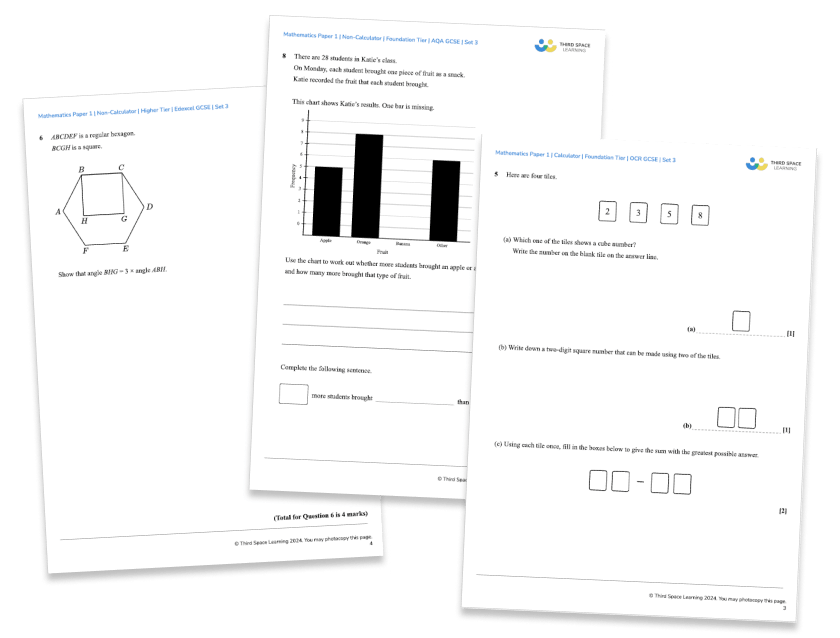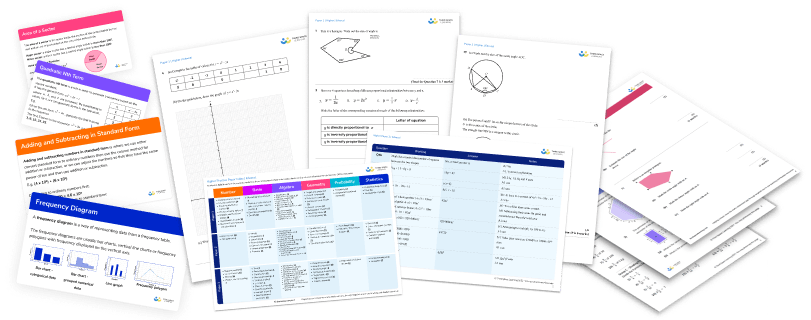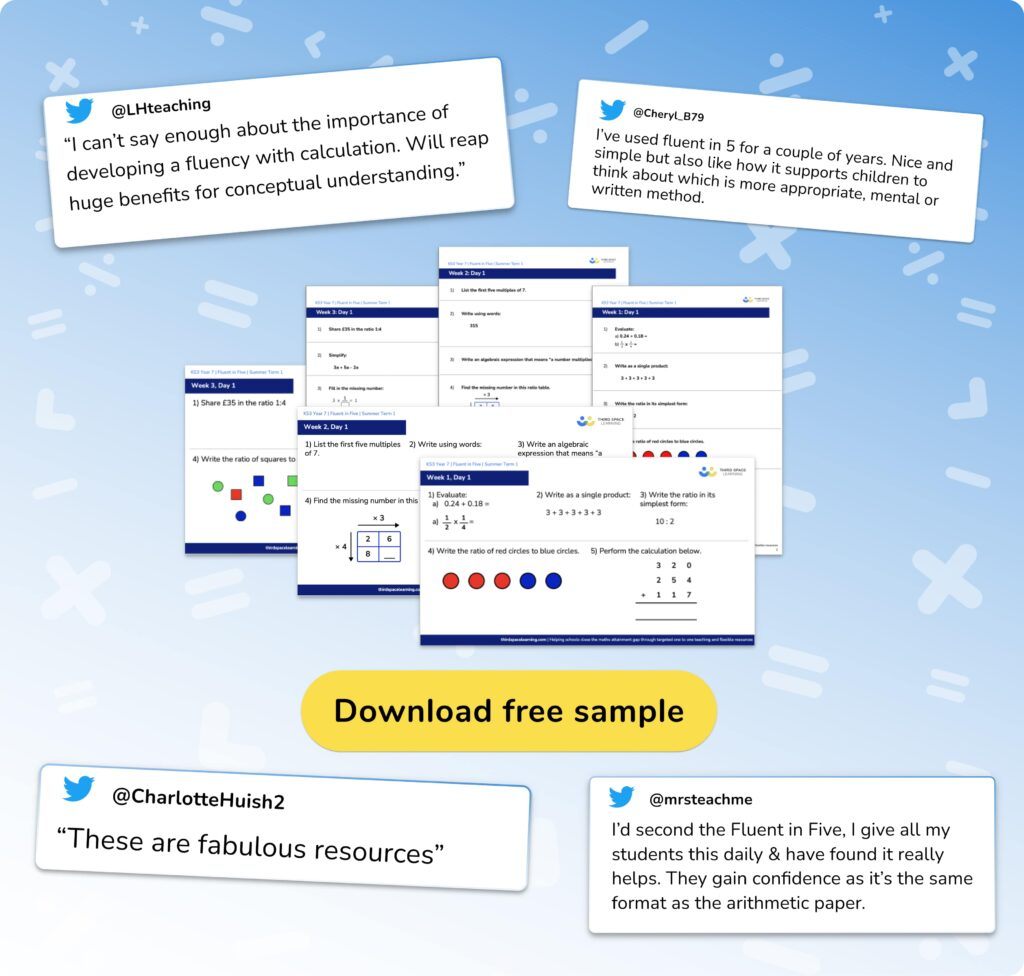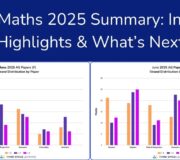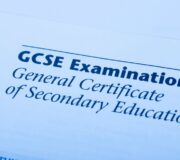GCSE Maths 2024 Summary: Insights, Highlights & What’s Next
This article was originally published on 21st August 2024.
Over the summer 2024 exam season, I’ve conducted in-depth analyses of Paper 1, Paper 2 and Paper 3, discussing the content and predicting future topics.
In my penultimate blog, I reflect on the entire exam series, including which subjects were tested procedurally and which included further complexity.
I’ll also save you time by identifying any gaps in the series to suggest what might appear in the November resits or June 2025 exams to help you plan for the coming school year.
Highlights from the GCSE Maths papers 2024
- Both tiers of papers had a mixed reception; students found Papers 1 and 3 particularly challenging, but had an easier time with Paper 2;
- Foundation tier had a higher proportion of procedural questions and a lower proportion of multi-step unfamiliar problems compared to the “average” paper, whereas the Higher paper was much closer to average distributions;
- As usual, some topics appeared twice or more across the series, and some topics weren’t assessed in depth. These include trigonometry and circle mensuration in Foundation, and systems of non-linear equations in Higher.
GCSE MATHS 2026: STAY UP TO DATE
Join our email list to stay up to date with the latest news, revision lists and resources for GCSE maths 2026. We’re analysing each paper during the course of the 2026 GCSEs in order to identify the key topic areas to focus on for your revision.
GCSE dates 2026
GCSE results (2026 when available)
Get ahead on revision with the GCSE maths papers analysis from 2025:
Analysis of GCSE Maths Paper 1 2025
Analysis of GCSE Maths Paper 2 2025
GCSE Maths Paper Analysis and Summary 2025
GCSE Maths Teacher Survey Results 2025
Expected challenge in GCSE maths 2024 papers
While this year’s Edexcel papers felt more challenging than June 2023, this was likely expected. Last year’s papers had some of the highest grade boundaries since the introduction of the new specification in 2017, indicating that the level of demand was quite a bit less for 2023’s candidates.
The papers felt fair, balanced and fitted with the general patterns of previous papers. The difficulty ramp at the start of each paper remains more gradual than in pre-pandemic papers.
GCSE Maths Topic List
Your go-to year-on-year GCSE maths topic list for every student to focus revision for exams. Covering all main GCSE math topics, you'll get dedicated Foundation and Higher lists with links to our library of free downloadable resources. Features worksheets, exam questions, diagnostic questions, revision mats and much more!
Download Free Now!How we measure complexity
- C1 – standard procedural problems, often worth one or two marks;
- C2 – problems asking candidates to explain their reasoning, interpret information from tables, diagrams or other contexts, or ‘show that’ type questions;
- C3 – non-standard multi-step problems, often requiring the application of skills from a variety of topics, worth three, four, or more marks.
This measure helps to direct focus for exam revision. You can see where it’s worth investing time in unfamiliar problems or contexts by targeting those topics most likely to be assessed in that way.
2024 maths papers included some unusual topics
In every exam series, some questions combine topics in an unusual format or contexts not previously encountered. At the start of the new specification, quite a lot of the questions felt different, but as we’re more used to this specification now, this seems to have eased off somewhat.
TOP TIP: It’s good practice to include versions or variations of these in schemes of work to cover when these topics are taught.
Here are a few of this year’s curveball questions.
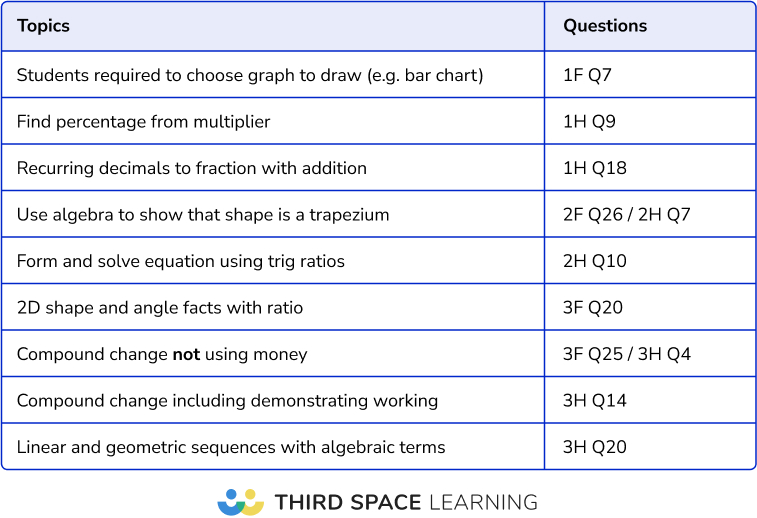
June 2024 GCSE Maths Papers: Foundation
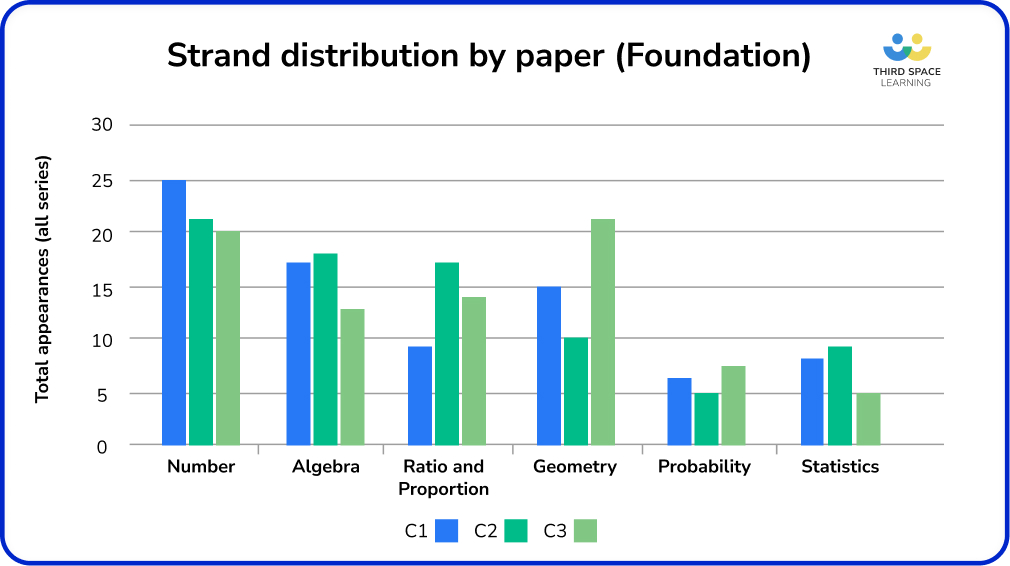
- More marks available for Number any other strands (particularly on the non-calculator Paper 1)
- Algebra and Geometry proportions varied across the three papers
- More Geometry than average on Paper 3
- More marks available for Algebra than average
- Fewer marks for Ratio & Proportion than average
Number was the highest strand
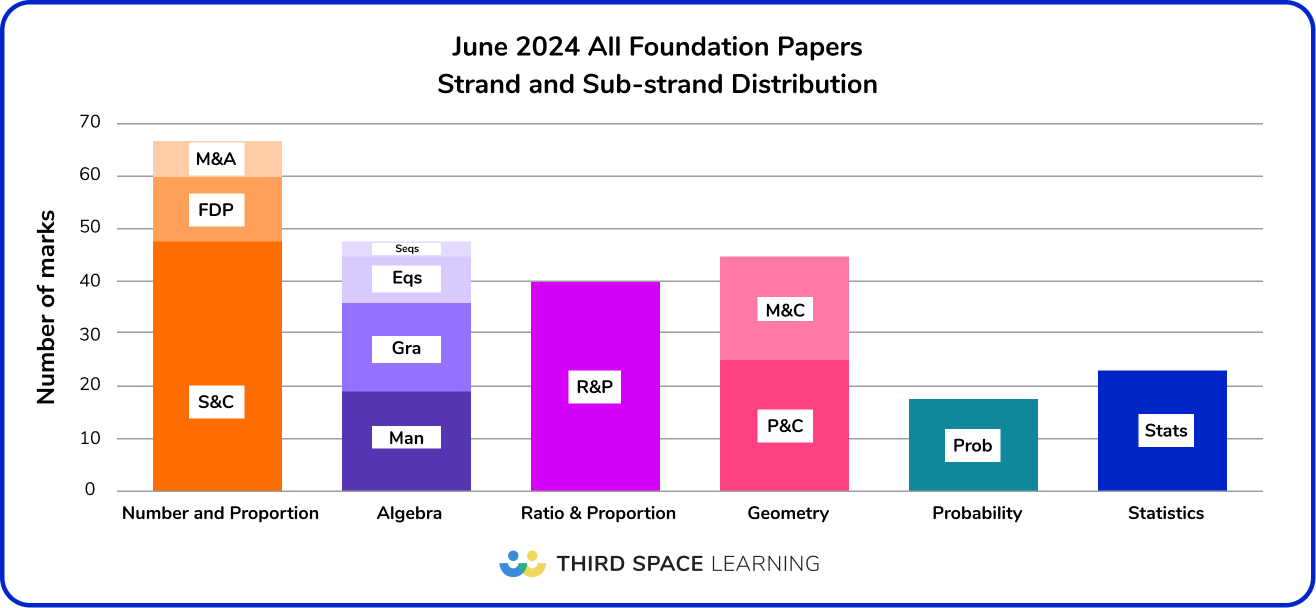
Number
- 73% of marks within Number were for Structure and Calculation.
- 50% of these marks were for Calculations using four operations with integers and fractions.
- Other number topics didn’t feature as highly as on some previous series.
Algebra
- 40% of the marks within Algebra were in Notation, Vocabulary and Manipulation, including factorising expressions, substitution and working with algebraic expressions.
- 35% of the marks in Algebra were in Graphs (significantly more than the average).
Ratio and proportion
- Many of the marks within Ratio & Proportion were for ratio calculations and work with units of measurement, including unit conversions and compound measures.
- Fewer marks than average for this strand.
Geometry
- An unusual skew towards Properties and Calculations within Geometry.
- Perimeter and area focused solely on rectilinear shapes.
- Very limited assessment of Pythagoras.
- Trigonometry was not assessed.
Probability and Statistics
- More Statistics questions than Probability.
- More Probability on Paper 3 and more Statistics on Paper 2.
- No assessment on sampling or scatter graphs in Statistics.

Unlimited GCSE maths tutoring with Skye, the voice-based AI maths tutor.
Built on the same principles, pedagogy and curriculum as our traditional tutoring but with more flexibility, reach and lower cost.
Help your GCSE students achieve their target grade with Skye’s one to one maths tutoring.
Watch Skye in actionFoundation favoured procedural problems
While the complexity measure isn’t necessarily correlated with the perceived difficulty of the exam, we do tend to find that papers which students perceive as “easier” have a higher than average proportion of standard procedural (C1) questions.
However, it is noteworthy that this year’s complexity proportions are identical to June 2023, but students have anecdotally found the papers more difficult.
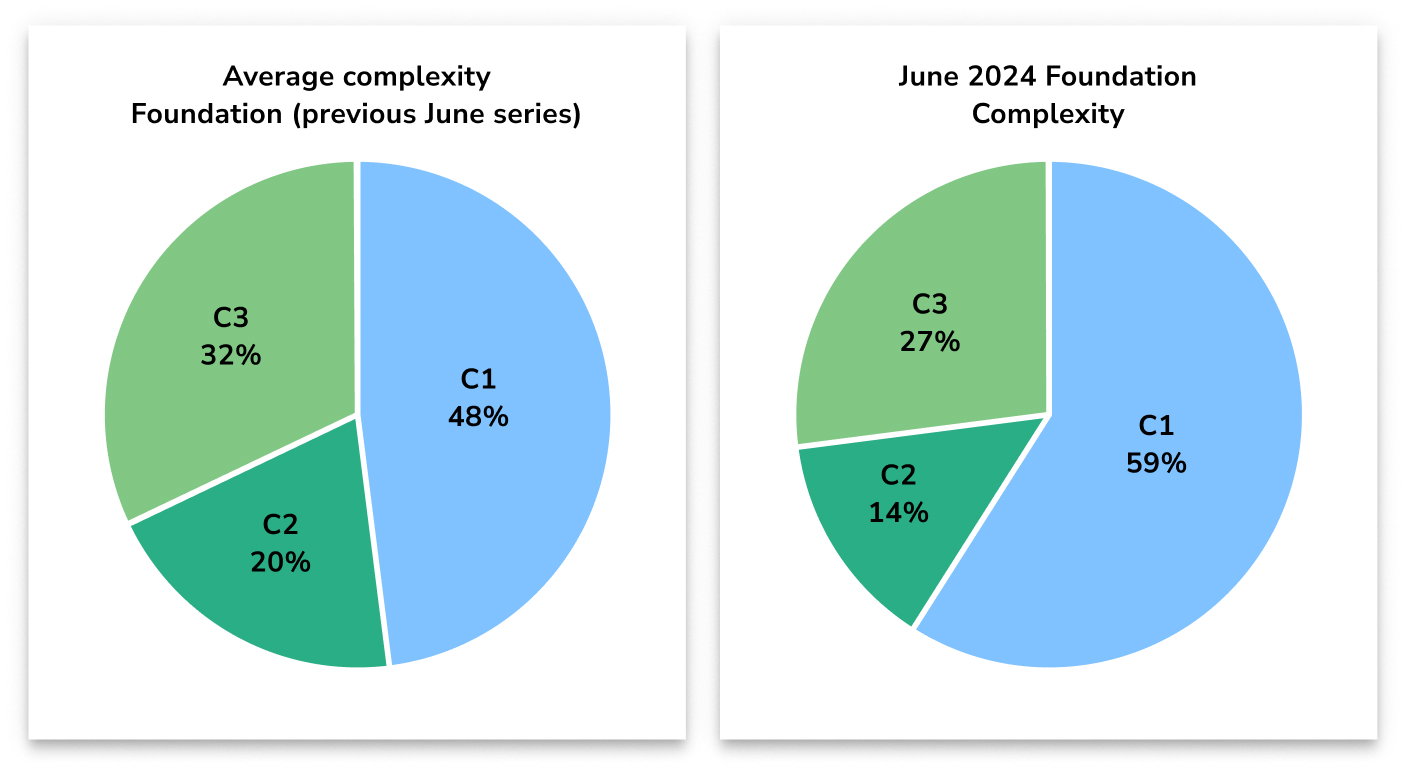
As noted last year, if we look at the complexity measure over the previous June series, the spike in the proportion of C1 questions on Foundation looks quite pronounced.
However, if we look at the trends in the pandemic papers: the two papers used in the November 20/21 sittings, and the 2022/23 series with adaptations, this skew seems less apparent.
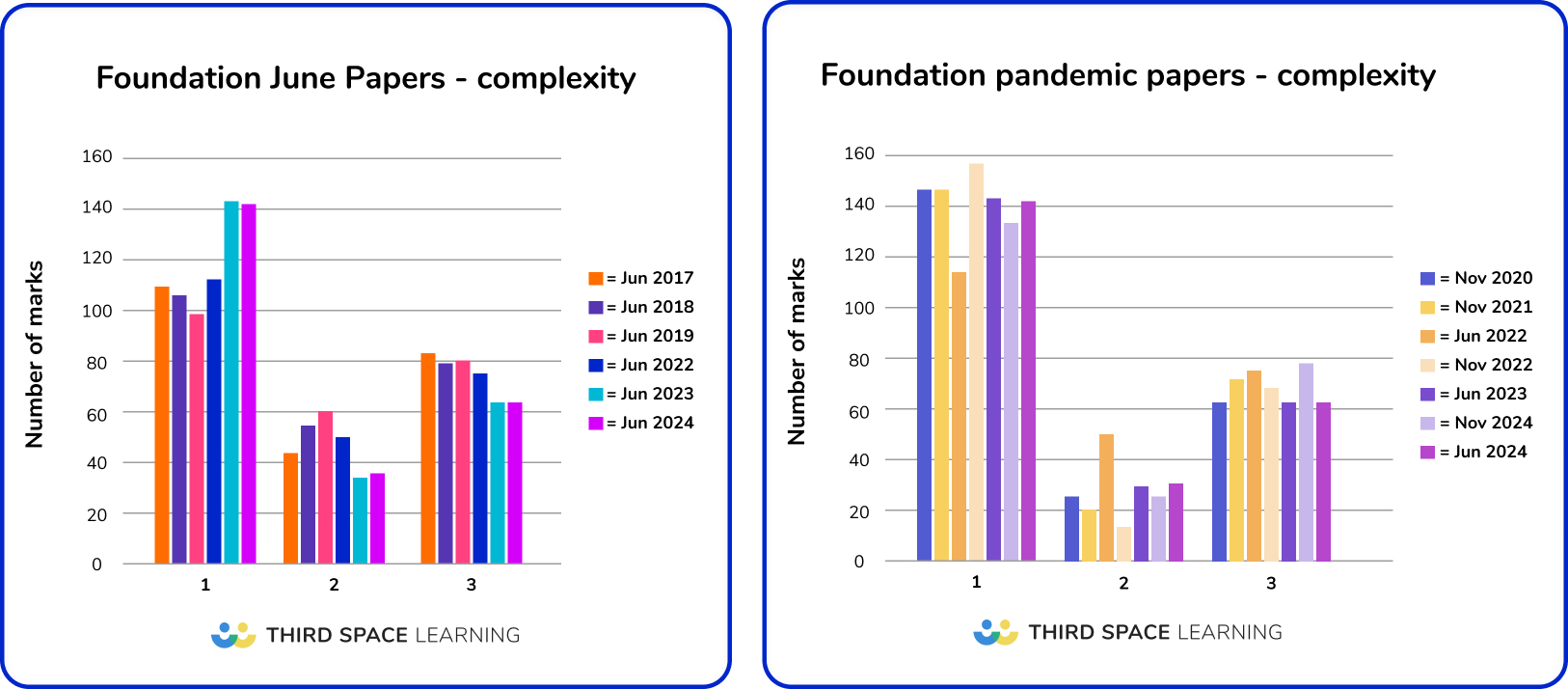
Missing content from the 2024 Foundation Papers
This is not an exhaustive list, but some of the topics that weren’t examined in any of the three Foundation papers include:
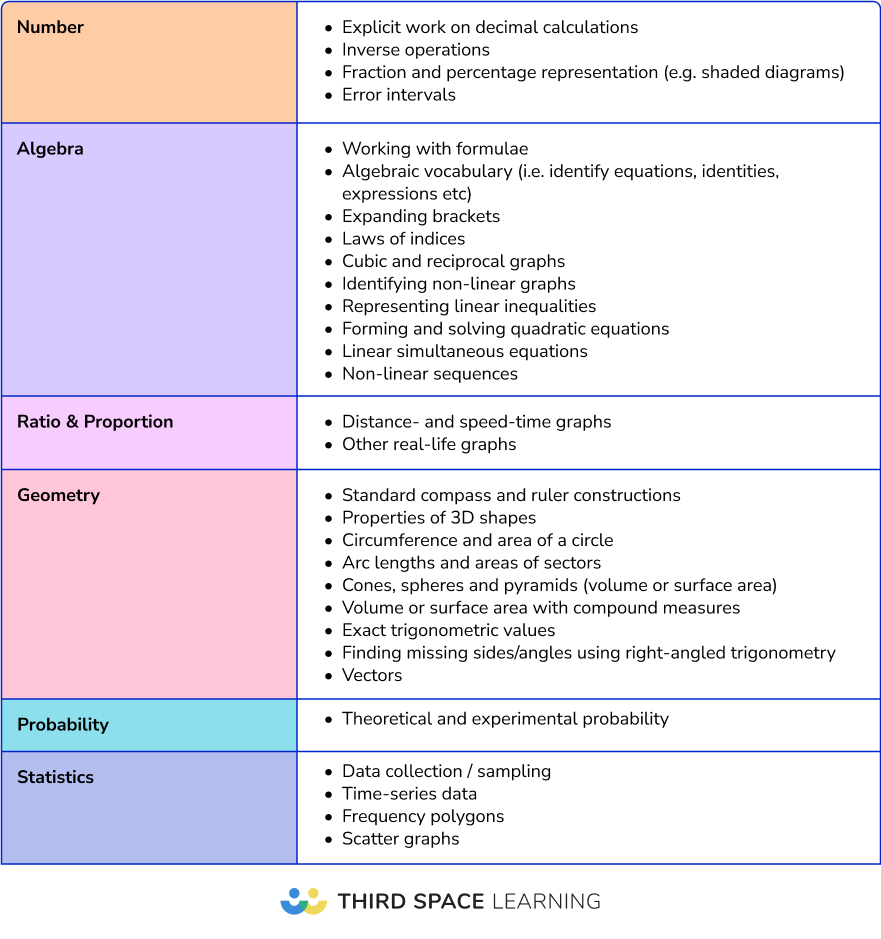
Quite a few of these topics (particularly within Algebra) are underlined on the GCSE specification, indicating content directed at the top end of the Foundation paper. This means that they often appear in crossover content and there is not enough room for assessment of each of these on every exam.
Their absence from this series and the 2023 series raises the likelihood of them appearing next time – particularly work on circles and right-angled trigonometry.
Similar complexity to previous years
While there is nothing highly unusual in this series of papers, there are a couple of slight deviations from typical patterns with GCSE Foundation papers:
- A typically heavy weighting towards Number content, but slightly less Ratio & Proportion than average;
- A slightly higher proportion of Algebra work than Geometry (this skew is usually the opposite way round).
As is typical on Foundation papers, most Algebra, Statistics and Probability content was assessed procedurally. We also saw a few more C1 questions and fewer C3 questions than on some previous series.
Complexity: Number
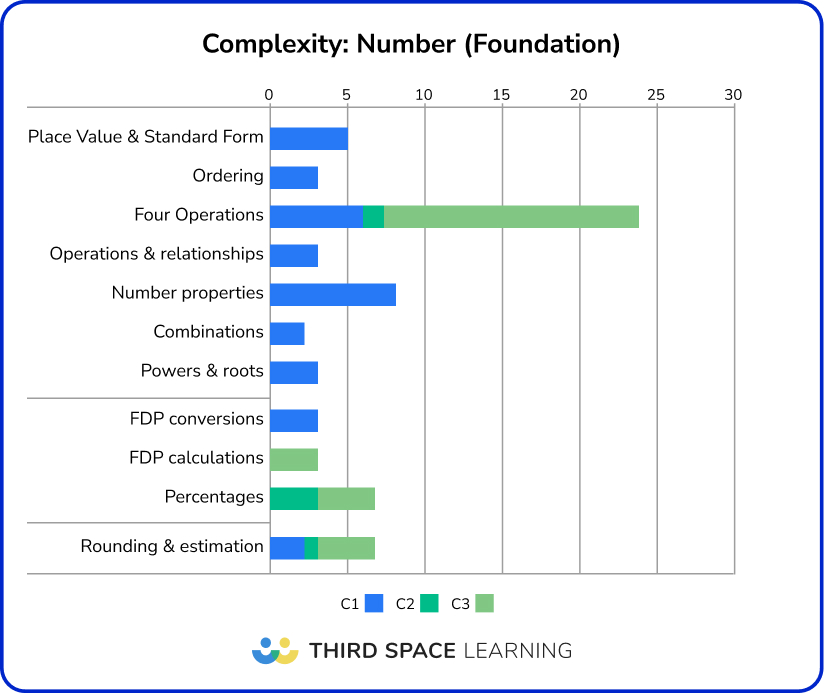
An unusually large chunk of Number marks came from calculation work with four operations.
The Majority of the C3 marks for multi-step problems involving real-life contexts or money calculations. The remainder of the C3 marks fell in Percentages, FDP calculations and rounding.
There were some accessible C1 marks available in the following topics:
- Powers and roots
- Number properties
- Ordering
- Operations
- Relationships and Fractions Decimals and Percentages conversions
Complexity: Algebra
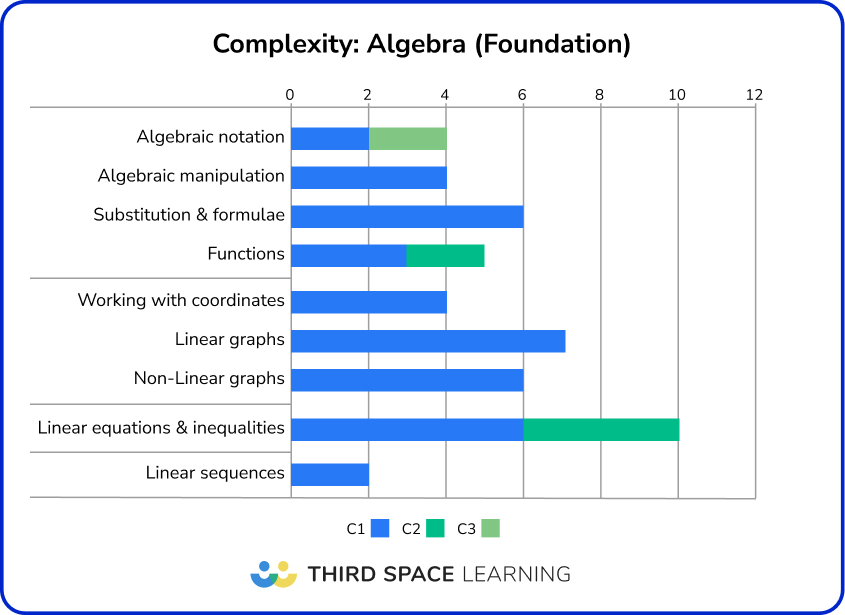
As is typical in the Foundation series, Algebra was generally assessed in a procedural manner. There were plenty of fairly straightforward marks up for grabs, particularly in:
- Functions
- Sequences
- Substitution
The large amount of graph work was assessed procedurally, but it is likely that candidates will have struggled with this regardless.
A context-based problem on Paper 3 required candidates to write an expression for the number of points awarded for playing a game. Another fairly challenging “show that” question appeared on Paper 2 requiring candidates to form and solve equations to prove that the given shape was a trapezium.
Complexity: Ratio and proportion
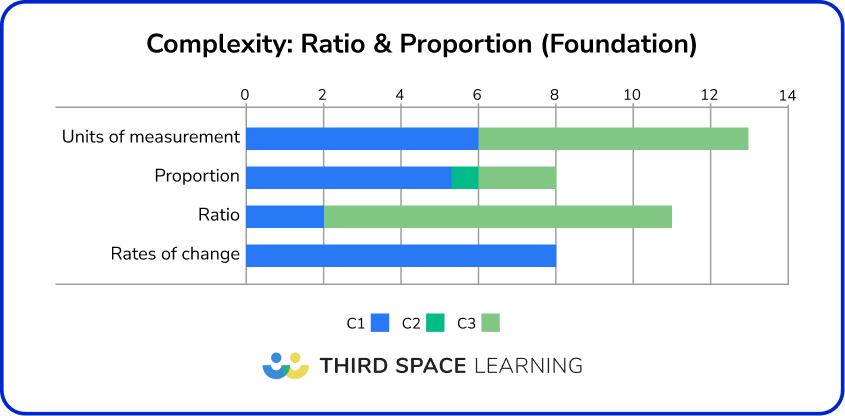
Ratio and Proportion marks were less than average across the series. But patterns and distributions within the strand remained fairly standard.
It is unusual to see no C2 or C3 questions on standard percentage increase, decrease or compound change, particularly as these topics featured more prominently than usual.
Complexity: Geometry
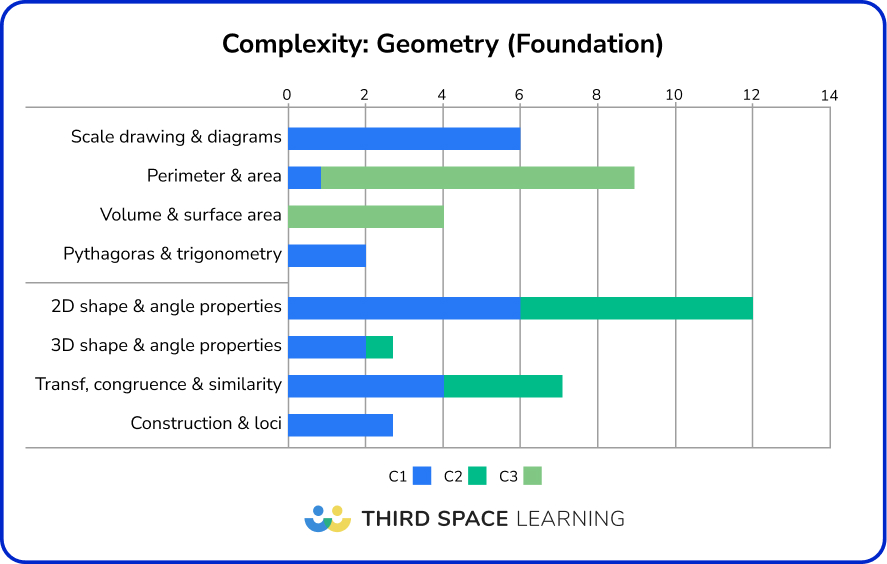
Complexity balance this year followed average patterns:
- The majority of C3 content was in perimeter, area and volume;
- C2 marks appeared in properties and constructions for explaining reasoning.
This series saw a continued low proportion of work on Pythagoras and Trigonometry. There was also no appearance of vectors for the third year in a row.
Loci appeared on the GCSE 2024 Paper 2; this is the first time it has appeared as a main topic since June 2017!
Complexity: Probability
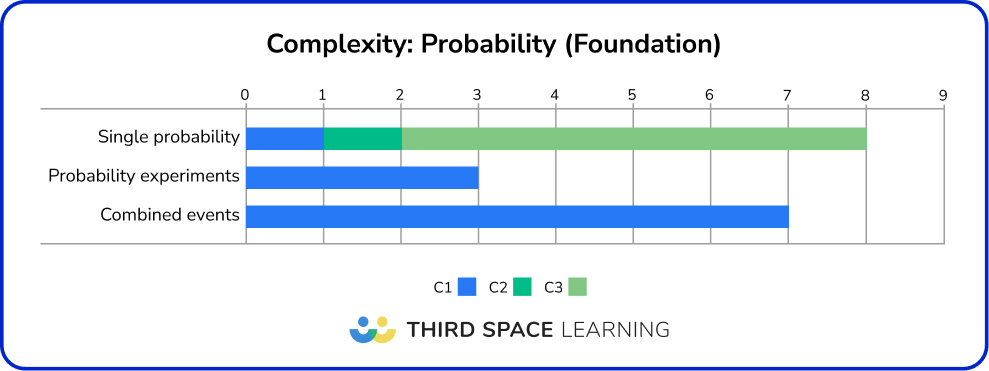
Probability provided lots of accessible and procedural with fairly broad topic coverage. The proportion of C3 marks available is higher than average.
Candidates had to answer a fairly challenging worded problem on Paper 1, then tackle a multi-topic question involving ratio and mutually exclusive events on Paper 2.
Complexity: Statistics
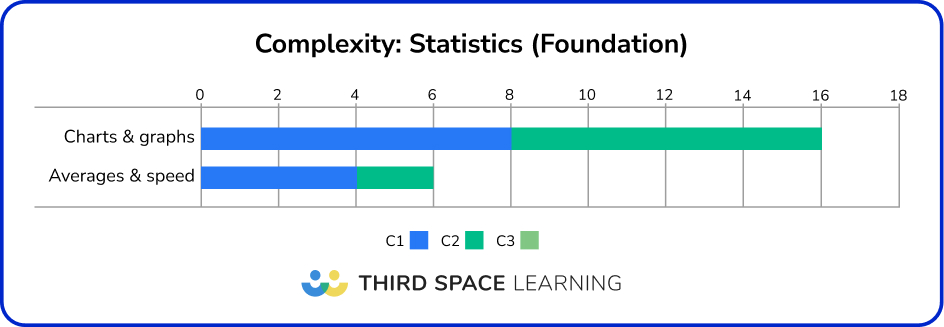
Statistics typically includes lots of C2 work. For example, asking candidates to interpret or read from charts and tables.
This pattern continued in June 2024, asking students to select an appropriate chart (rather than directing them to a bar chart) on Paper 1 felt slightly more challenging.
The majority of Statistics work was accessible or procedural, including work on:
- Bar charts
- Pictograms
- Pie charts
Interestingly, there was no Statistics content in the common questions in any of the papers.
June 2024 GCSE Maths Papers: Higher
Varied topic distributions across the Higher papers
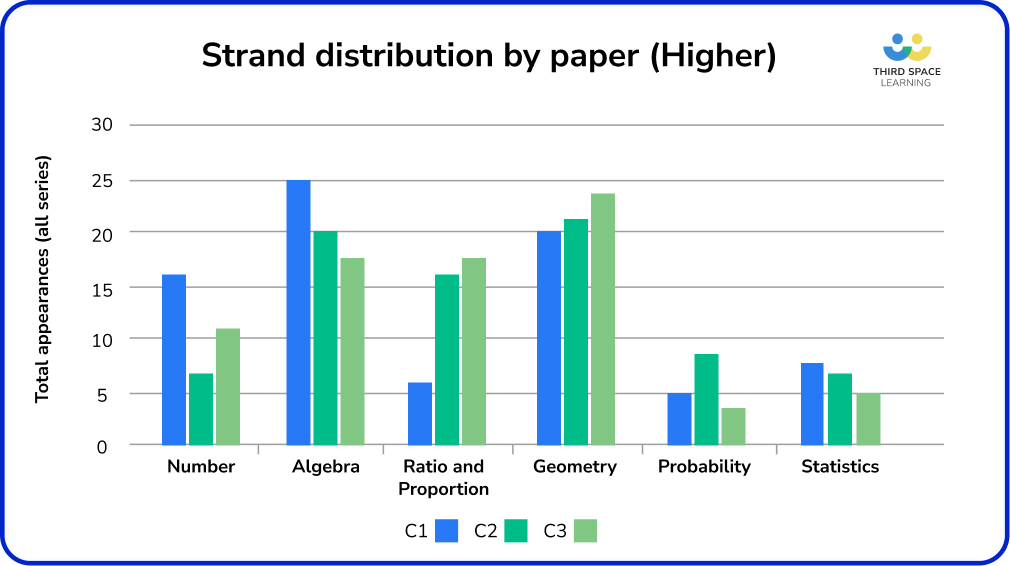
- More Number on Paper 1 due to the assessment of non-calculator arithmetic on this paper.
- Fewer marks overall in the Number strand than on previous papers.
- More Algebra and Geometry on Papers 2 and 3.
- Slightly more Geometry than Algebra overall.
- Marks for Ratio and Proportion significantly lower than average on Paper 1.
- More variation in the distributions of Probability and Statistics than in previous series.
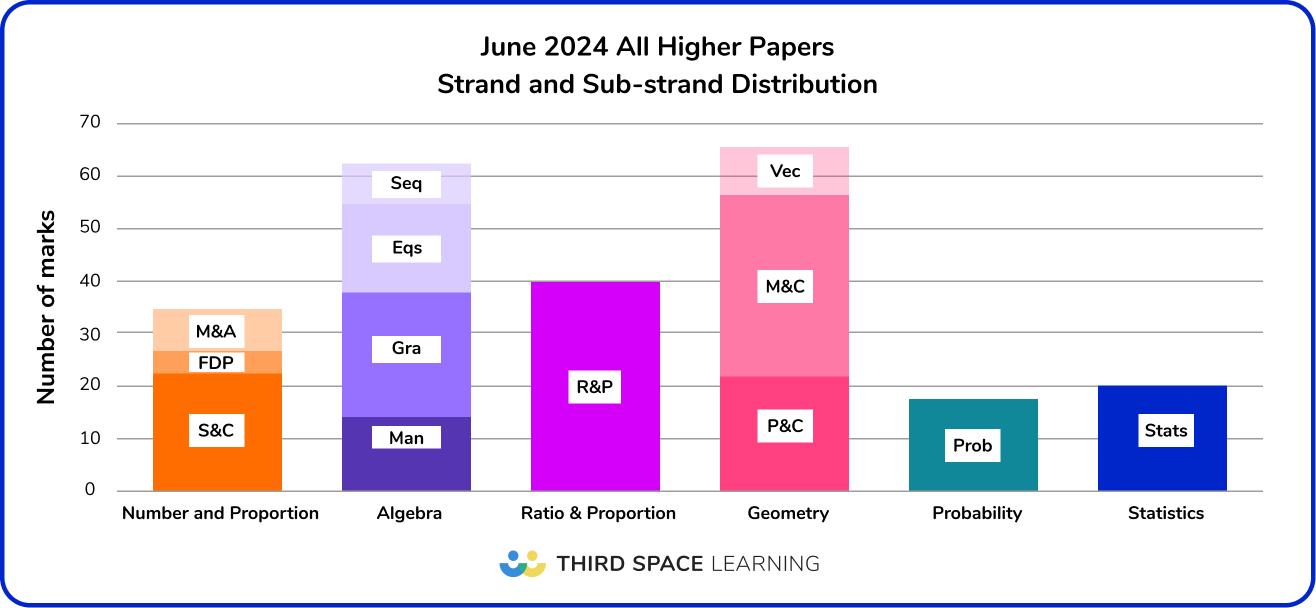
- Algebra and Geometry were the main focus in the Higher series.
- Many Geometry marks came from Mensuration and Calculations. However, the traditional skew was slightly less pronounced than previously.
- More work on Structure and Calculations.
- Fractions, Decimals and Percentages sub-strand attracted fewer marks than average.
- Sequences sub-strand of Algebra was more prevalent than in some previous series.
- Graphs accounted for 10% of the total marks for the whole series, significantly higher than usual.
- Statistics and Probability had gaps within both strands.
- Charts and Graphs attracted far more marks than Averages in Statistics.
- A large proportion of Probability work focused on Combined Events.
Return of more complex problems to the Higher tier
Unlike Foundation, where we saw a higher proportion of standard procedural (C1) questions and a lower proportion of multi-step unfamiliar (C3) problems, the complexity distribution for the Higher papers is much closer to the average for all series.
We’ve seen a marked uptick in the marks available for C3 questions compared to last year’s June papers. 43% in 2024 compared to 34% in 2023. This may explain why some students found these papers challenging.
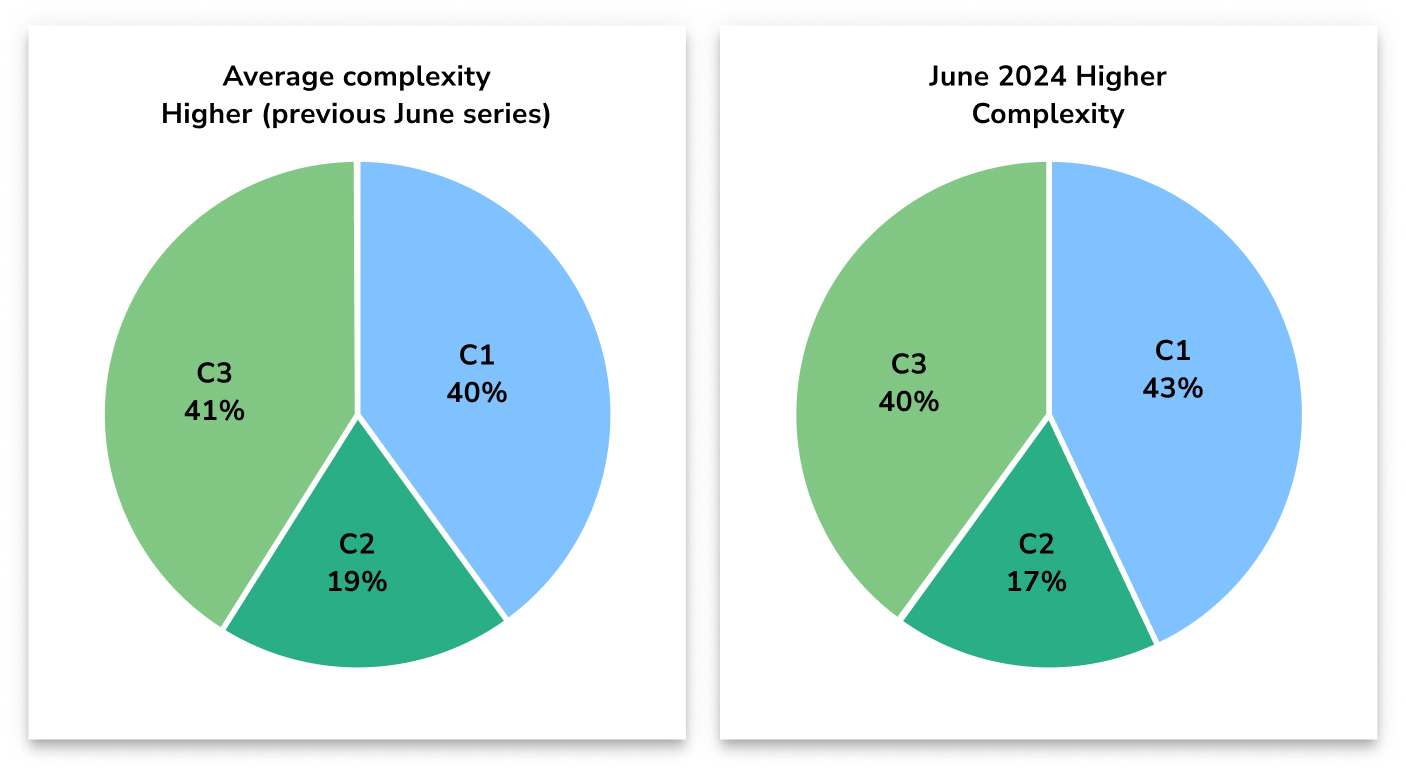
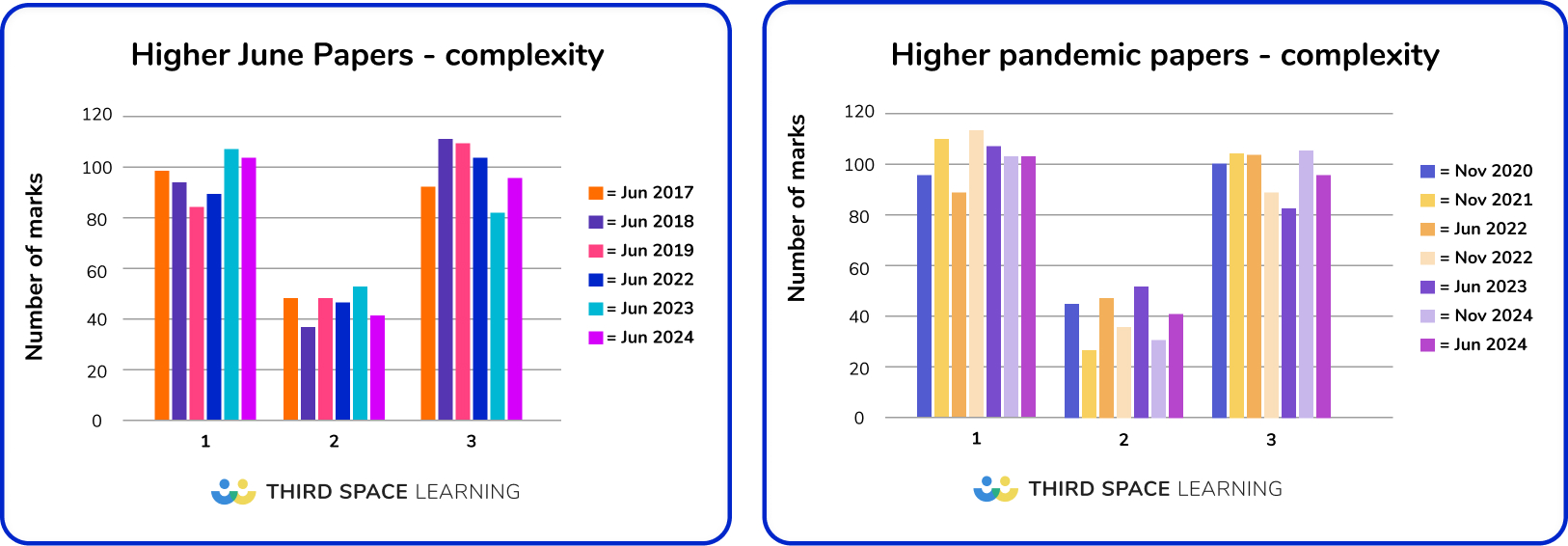
Missing content from the June 2024 Higher papers
This is not an exhaustive list, but these are the most notable missing topics:
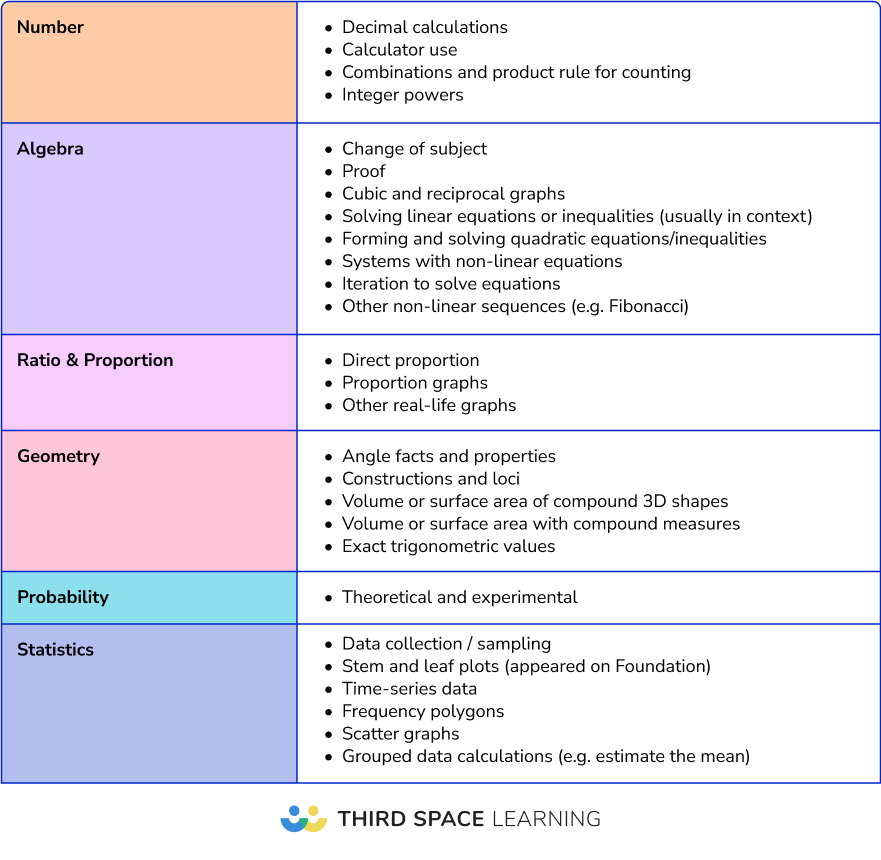
Although this does not ensure that these topics will appear in the next series of papers, teachers should consider them more likely to be assessed when preparing students.
Unsurprising complexity but some topic strand variations
The pattern with GCSE Higher papers is generally:
- Mostly procedural Number calculation work;
- A higher proportion of multi-step problem solving and reasoning in FDP, Geometry and Ratio and Proportion;
- A mix of procedural, reasoning and more complex problems in Algebra, Statistics and Probability.
This year’s series is very close to the average, with no surprises in the assessment of particular topics.
Complexity: Number
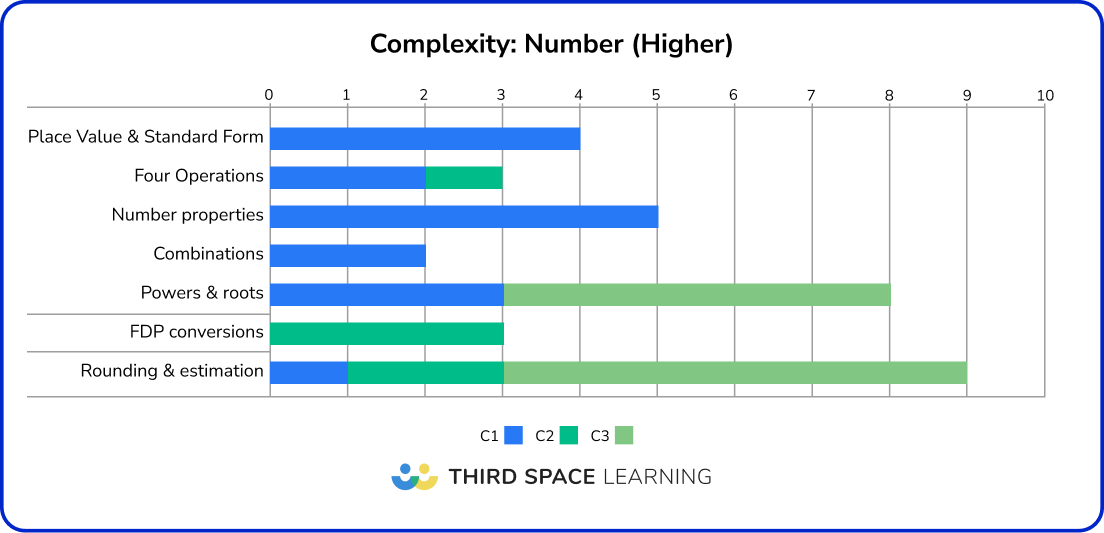
Many of the Structure and Calculation topics in the Higher paper were assessed procedurally (C1) except for work on powers and roots. This included some complex multi-topic problems on Papers 1 and 3.
Rounding and estimation attracted more C3 marks than typical due to multi-topic combinations, including uisng an algebraic formula and standard form in the bounds question on Paper 3.
Complexity: Algebra
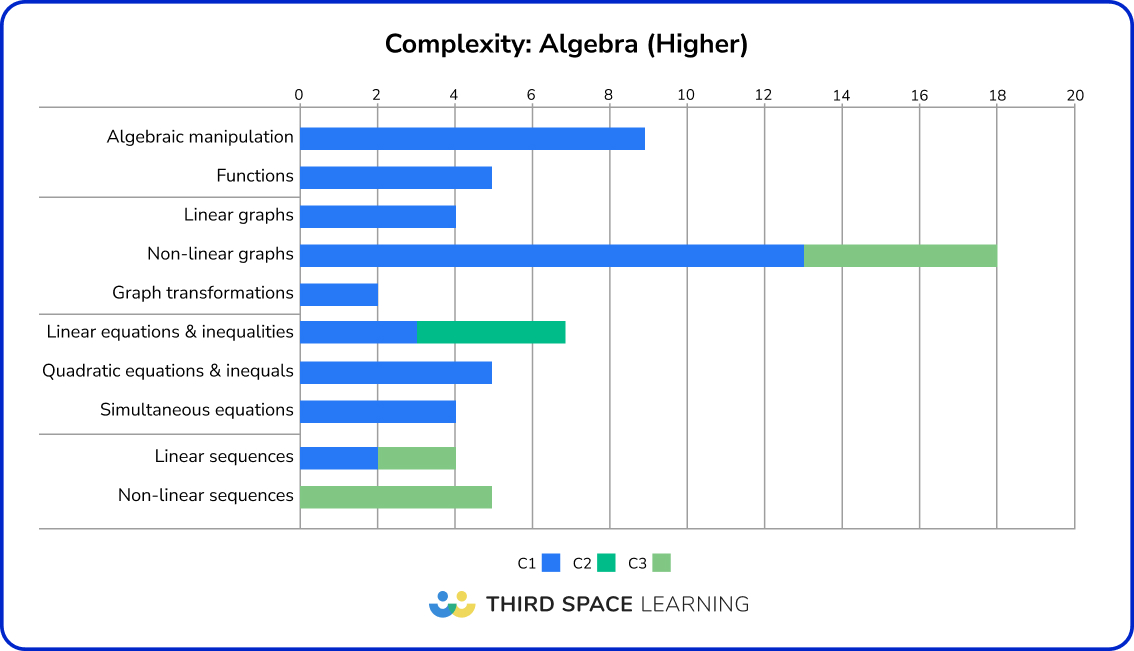
Algebra was assessed more procedurally than previous Higher series. There were also fewer proofs or “show that” questions than last summer’s papers.
Comparatively, there was little C3 content, except for the Sequences sub-strand where we saw the 7-mark question on Paper 3.
This problem required students to apply their understanding of linear and geometric sequences to problems with algebraic terms.
Complexity: Ratio and proportion
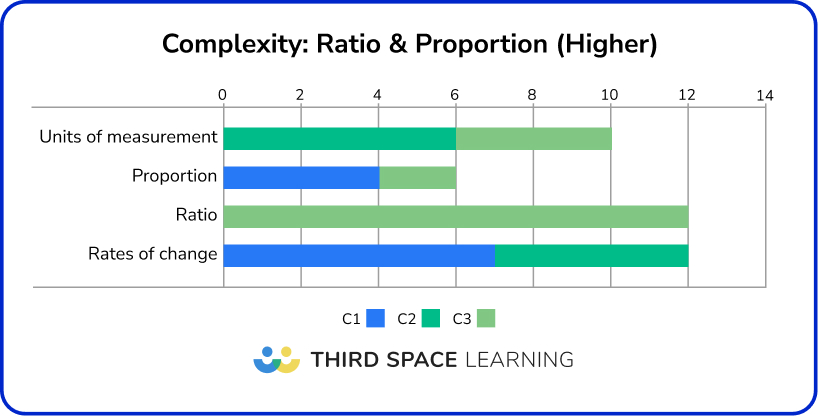
A high proportion of C2 and C3 appeared across Ratio & Proportion.
Many of these were familiar multi-topic combinations, such as the jar problem on Paper 1. Candidates were required to work with fractions, ratios and percentages, including combining two ratios.
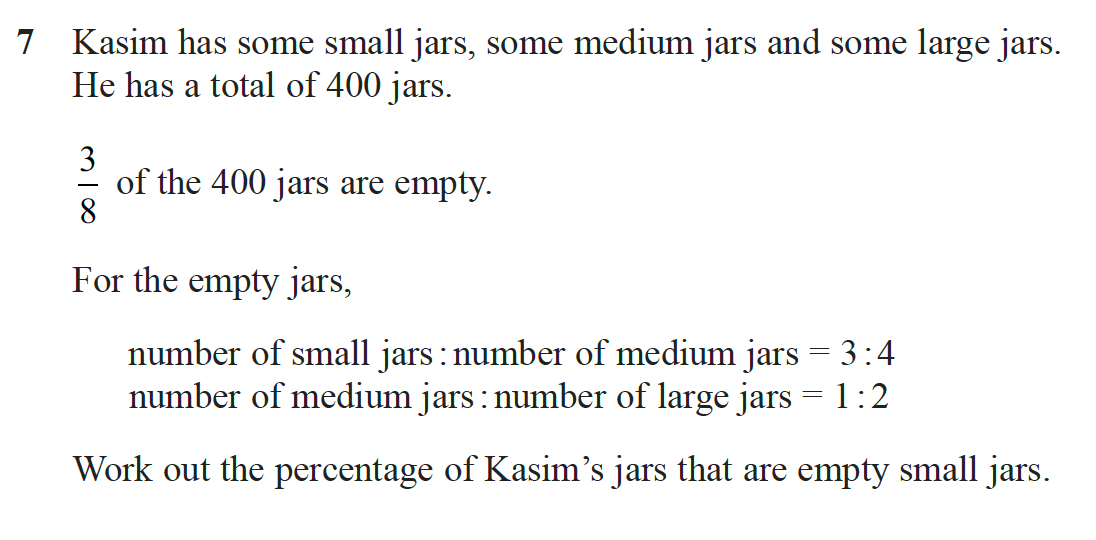
The high proportion of C1 questions within rates of change comes from two fairly accessible problems on compound change, and iteration/growth and decay.
Complexity: Geometry
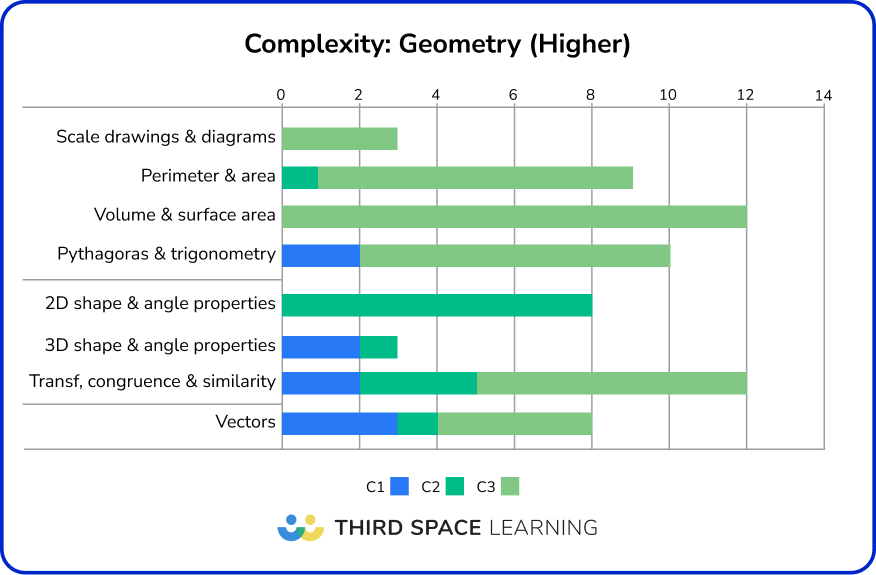
A common pattern in the Higher paper is a majority of C2 or C3 questions in Geometry. Usually, these are:
- Proofs
- Reasoning
- Unfamiliar multi-step problems
In Mensuration and Calculation, over 90% of the content was C3 – significantly higher than in June 2023.
Volume and Surface Area were worth 5% of marks in the overall series.
Additionally, there was plenty of work on Pythagoras and Trigonometry for Higher candidates.
3D shapes, angle properties and vectors appeared more frequently than previous years.
Complexity: Probability
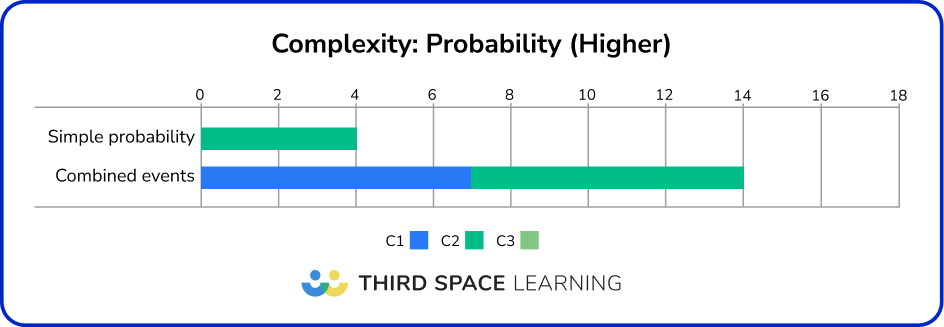
Nearly all marks in the Probability strand came from work on combined events, mostly Venn diagrams and solving problems using independent and dependent combined events.
It was, however, fairly unusual to see no C3 marks in this strand, meaning no significant surprises for candidates this year.
Complexity: Statistics
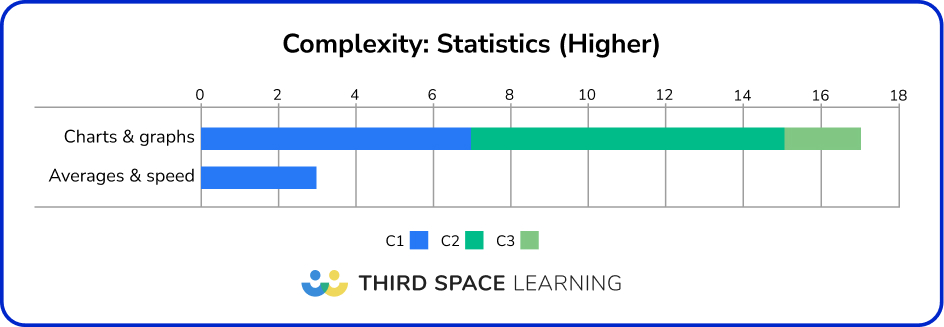
Nearly all of the Statistics content this year involved charts and graphs.
Histograms, cumulative frequency graphs and box plots also appeared in this series.
There was some context-based work on Averages and Range, such as reading graphs, but no work on sampling or data collection.
What are the implications for teaching next year?
Here are some teaching strategies to integrate the insights from this year’s exam papers into your teaching for the upcoming academic year:
- Incorporate challenging or unusual problems from this year’s exams into teaching materials for the next cohort of Year 11s.
- Repeated or scaffolded variations of challenging problems can be especially beneficial.
- Include the less-standard topic crossovers referenced more frequently in your lessons.
- Use student feedback from this year’s cohort to identify which questions they found difficult on the exams and determine if current learning materials need adjustments to address these gaps.
- Consider how you will use question-level analysis for your cohort. Are there specific teaching gaps within your department not reflected nationwide? This may indicate a need for departmental CPD or sharing of best practices on key topics.
Third Space Learning’s online, one-to-one GCSE revision tuition can help identify gaps in learning and help students to prepare for the exams. By using initial and on-going assessment, we generate bespoke learning programmes that focus on the areas that will have the most impact on student progress.
Third Space Learning also offers a wide range of FREE resources and revision guides to support students in their studies, such as our popular Fluent in Five pack! See the full range of free secondary resources here.
DO YOU HAVE STUDENTS WHO NEED MORE SUPPORT IN MATHS?
Skye – our AI maths tutor built by teachers – gives students personalised one-to-one lessons that address learning gaps and build confidence.
Since 2013 we’ve taught over 2 million hours of maths lessons to more than 170,000 students to help them become fluent, able mathematicians.
Explore our AI maths tutoring or find out how our GCSE maths tutoring programmes could support students in your school.
